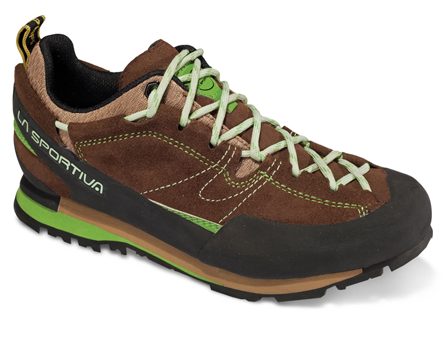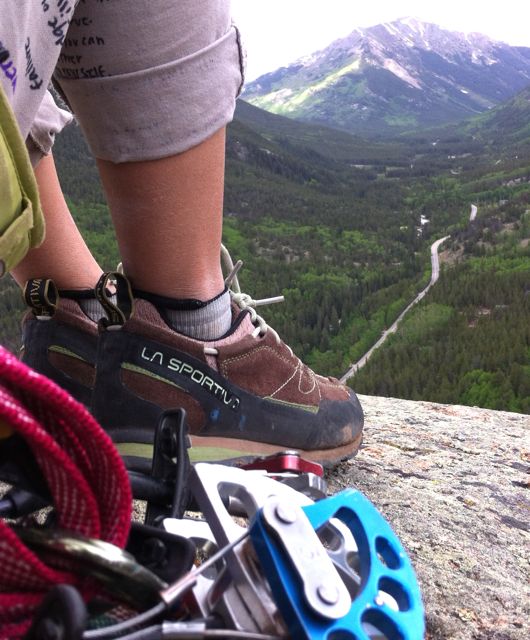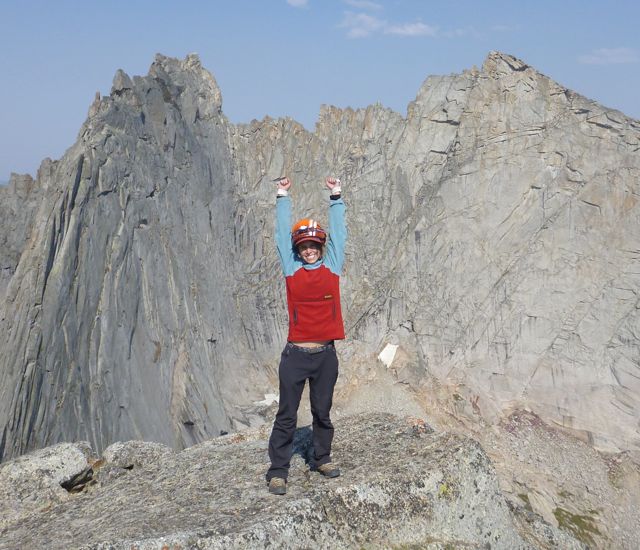
La Sportiva Women’s Boulder X
Weight: 16.97 oz / 481 g
Sizes: 36 – 48 (half sizes)
Size Tested: 37
Construction: Board Lasted
Upper: Leather
Lining: Mesh (back half and tongue only)
Sole: Vibram Idro-Grip V-Smear Impact Brake System
Reviewer’s Feet: 225mm long; 89mm wide
MSRP: $105
Days Tested: 60 +
Locations Tested: Crestone Needle, Shelf Road, Independence Pass, Leadville, Elks Range, Mount of the Holy Cross, Manitou Experimental Forest, Boulder Canyon, Turtle Rock, and 22 days of backpacking in the Sawatch Range, CO; Wind River Range, WY
Yesterday, we ran a review of the Five Ten Women’s Guide Tennie. As I mentioned in that piece, climbers seem unusually loyal to their respective approach shoes, so in an effort to dispel some of the mystery surrounding this phenomenon, I’ve reviewed both the La Sportiva Boulder X and the Guide Tennie. Let’s see how the Boulder X compares.
First Impressions
When I first slipped on this shoe, I was surprised by how different it felt from the Guide Tennie. The Tennie sits lower to the ground, more like a gym shoe, and it’s roomier from top-to-bottom than the Boulder X. The Boulder X has a thicker, more hiking-boot-like outsole than the Guide Tennie, making it more suitable for varied terrain.

Fit
La Sportiva’s Boulder X is definitely less minimal than the 5.10 Guide Tennie. The tongue of the shoe is padded, so it feels pretty luxurious for an approach shoe when you slip it on your foot. The interior of the shoe is tight and hugs your foot, making it feel more like a comfy trad shoe than a trail runner or a hiking boot.
The toe box is also more like a trad shoe than a true hiking boot. Unlike the Scarpa Crux, which has a roomy toe box, the Boulder X follows La Sportiva’s classic, narrow, tapered toe box design. This makes it an excellent choice for more technical terrain, but it also decreases comfort on really long hikes.
At times, especially on long days or on downhill talus, the narrow toe box felt constricting. I wore the shoe on the descent from the Crestone Needle, and after having my feet shoved in climbing shoes for so long, then into the Boulder X for the steep downhill slog, my toes were pretty unhappy as they kept pushing into the front of the small toe box.
The outsole and bottom layers of the shoe are pretty thick, making the shoe taller than the Guide Tennie. The drop from the heel to the ground is 2.5 cm while the drop from the forefoot to the ground is 1 cm.

Sizing
The Boulder X seems to fit true to size unlike some other La Sportiva shoes that I’ve found to run small. I generally wear about a size 5 or 6 street shoe, and I’ve found that the Boulder X in a U.S. women’s 6 (or 37 Euro) fits about perfectly.
My only complaint in regards to sizing (and this won’t be an issue for most peopole) is that I had to break the shoes in significantly before I could fit my insoles comfortably. Before then, the snug, conforming nature of the shoe meant that there was no excess room for a light insole. However, after wearing the Boulder X all summer, I can now comfortably fit both my foot and my insole inside.
Tread
The Boulder X has a much more aggressive tread design than the Guide Tennie, making it more suitable for long approaches and light hiking.
It still sticks to rock remarkably well, and also functions better in wet and snowy conditions than the Guide Tennie. I took the shoe on an owl research trip in the spring where we encountered about 4 inches of snow, and it performed admirably.
The Guide Tennie quickly loses traction on wet terrain, ice and, snow, but the Boulder X maintains some amount of functionality in these conditions. It doesn’t hold up as well as typical hiking boots, and it will certainly slide on wet, lichen-covered rock, but the tread makes a big difference.

Technical Terrain
The Boulder X excels on talus and 4th-5th class terrain. I felt more comfortable in them than any hiking boots I’ve ever worn, especially on tricky, off-trail passes and peak attempts.
When it comes to vertical rock climbing, it does well enough on easy climbs, as in guiding situations, etc. It edges reasonably well and is still moderately sensitive, but I found that the Guide Tennie is more sensitive and better at smearing than the Boulder X.
Waterproofing
Although the Boulder X does pretty well in wet terrain, it’s not very waterproof. On a long trip through the Sawatch, they got soaked and, without the sun to dry them out, stayed cold and wet for another day and a half. So watch where you step.
Laces
The laces on the Boulder X are a great, minty-green color, but they’re wide and I’ve found them to untie easily. Perhaps I never quite learned the art of shoe-tying, but it seems that every time I get into cruxy, sketchy terrain, I look down to find my laces untied. You’re experience may vary, but it’s been an issue for me.
Bottom Line
Two celebrated shoes: the Five Ten Guide Tennie and the La Sportiva Boulder X. So which shoe should you buy?
If you want approach shoes that you anticipate using primarily for climbing, get the Guide Tennie. If you’re looking for a pair of shoes to tackle alpine climbs and quick, light peak attempts, the Boulder X will perform much better on varied, demanding terrain.
Although I’ve been using the Boulder X instead of hiking boots, I think it more effectively fits the niche between cragging and heavy hiking. It’s a little excessive for day trip top-roping, and a little too light for carrying serious packs.
